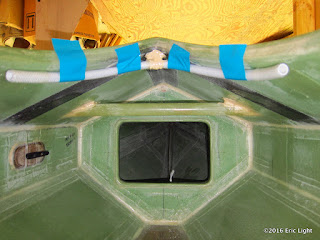Checking out the fit—upside-down:
 |
| The waterline is supposed to be just under the chine knuckle of the main hull, so it looks like the amas will be just kissing the water. |
 |
| Good view of the forward aka piercing the foredeck. |
Leeboard guard:
On the starboard side, quarter-inch mahogany ply makes a straight face for the board to pivot on. The ends of the 16"-long board happily just happen to be equidistant from both the centreline and the outside of the hull, meaning that the guard is right in the middle of the curve, or "dead amidships".
A super leeboard is in the works.












































